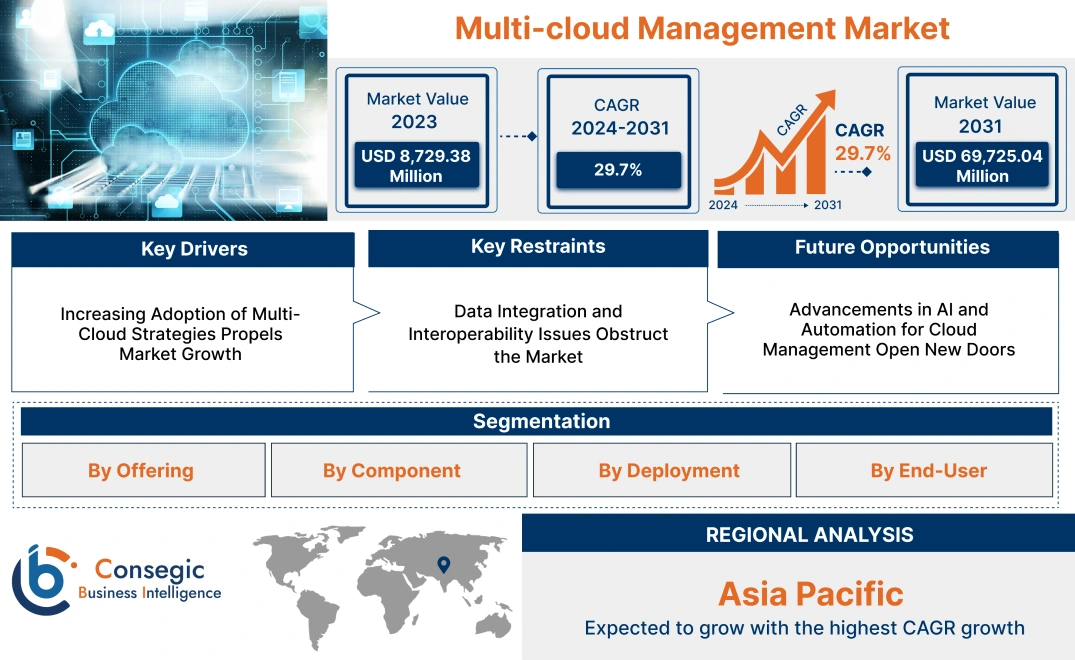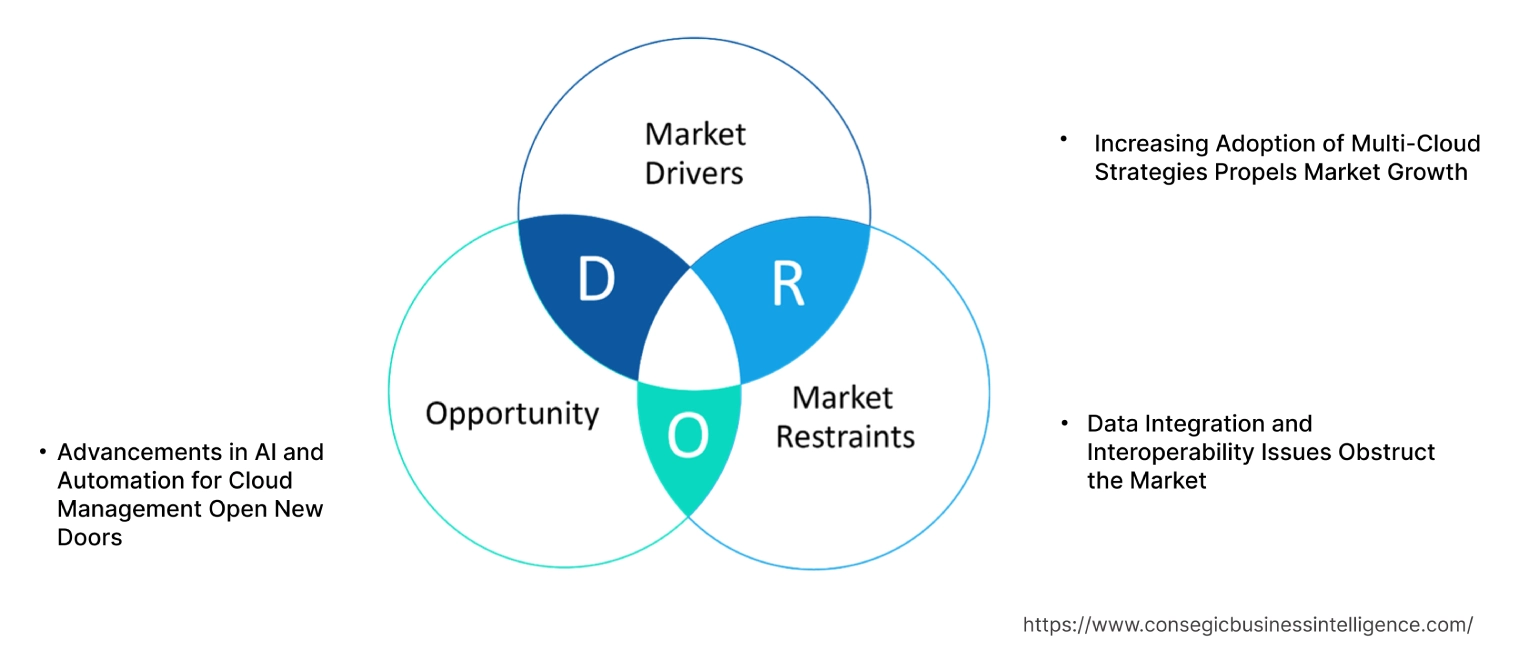- Summary
- Table Of Content
- Methodology
Multi-cloud Management Market Size:
Multi-cloud Management Market size is estimated to reach over USD 69,725.04 Million by 2031 from a value of USD 8,729.38 Million in 2023 and is projected to grow by USD 11,162.78 Million in 2024, growing at a CAGR of 29.7% from 2024 to 2031.
Multi-cloud Management Market Scope & Overview:
Multi-cloud management refers to the process coordination and optimization of various cloud services and providers within the organization. This ensures data security and compliance, with the seamless integration monitoring, and optimization of the cloud offering. The advantages include reduced risk, enhanced flexibility and scalability, and avoiding vendor lock-in. The primary end-use industries include IT companies, financial institutions, healthcare, and large-scale enterprises.
Multi-cloud Management Market Insights:
Key Drivers:
Increasing Adoption of Multi-Cloud Strategies Propels Market Growth
Multi-cloud management solves the issue of vendor lock-in and relying on a single cloud provider across enterprises, by providing flexibility, resilience, and reduced cost. Moreover, they distribute the workload, increasing the operational efficiency. This allows enterprises to enhance data security, and performance and utilize various cloud offerings.
- According to a 2023 article by Oracle, almost 98% of the Organizations dependent on the public cloud are increasingly moving towards the adoption of a multi-cloud strategy. This is due to the stability and agility provided to the business operations.
As per the multi-cloud management market analysis, the various cloud services provided and the workload distribution drive the market growth.
Key Restraints :
Data Integration and Interoperability Issues Obstruct the Market
Due to the different configurations provided by different cloud providers varying significantly, the integration of these systems becomes extremely difficult. This also makes the process of synchronization of data, processes, and applications across various platforms critical.
Moreover, the issue of no proper standardized protocol for data integration or interoperability, makes the operational cost extremely heavy and further delays the deployment process. This is due to the requirement of expertise in the area, as each cloud platform includes its customized set of tools including APIs and frameworks, leading to inconsistencies.
Therefore, as per the market analysis, the issues in data integration and interoperability are restraining the multi-cloud management market growth.
Future Opportunities :
Advancements in AI and Automation for Cloud Management Open New Doors
The integration of AI and automation significantly improves workload management, allocation of resources and detect threats, providing real-time insights, and further improving the decision-making process. Additionally, they reduce human intervention, reducing the scope of error and eventually increasing the work efficiency.
- In February 2024, the first AI Suite for Multi-Cloud Networking was launched by Prosimo, ensuring rapid decision-making and enhanced workload optimization. This ensures the organizations are provided with all the services in a single vertically integrated platform.
Thus, the automation of tasks and the security provided are expected to boost the multi-cloud management market opportunities.
Multi-cloud Management Market Segmental Analysis :
By Offering:
Based on the offering, the market is segmented into Platforms (Cloud Automation, Cloud Migration, Cloud Governance, Cloud Monitoring & Analytics) and Services (Professional Services and Managed Services).
Trends in the Offering:
- With the advances in cloud automation, businesses can handle complex multi-cloud environments, with tools to automate the infrastructure.
- Automation of tasks, real-time monitoring, and optimization of cloud performance are enabled with the advancements in AI and ML in the management services sector.
The platform (cloud automation) sector accounted for the largest revenue in 2023.
- The automation of repetitive cloud management tasks, scalability, and resource optimization is achieved through cloud automation.
- Complex cloud configurations, operational efficiency, and minimal human error, especially in multi-cloud environments are achieved using automation tools.
- The workload and manual interventions are reduced with the use of these automation technologies.
- In May 2023, the IBM Hybrid Cloud Mesh at ONUG was launched by IBM, in order to achieve the management and connectivity of the infrastructure. It is used to improve performance, cost, and availability.
- In conclusion the enhancement in efficiency and optimization of tasks is driving the growth of the cloud automation sector in the market.
The services (managed services) sector is anticipated to register the fastest CAGR during the forecast period.
- Companies can focus on core business operations, while management services assist in outsourcing cloud management tasks, increasing organizational efficiency.
- Businesses lacking expertise in managing complex multi-cloud environments, continuous monitoring, and troubleshooting, are benefitted from these services.
- For instance, the Forrester Wave™: Multi-cloud Managed Services Providers, Q1 2023, Tata Consultancy Services (TCS) was recognized as a leader. Additionally, it also secured the highest score in the category for the current offering.
- In conclusion, the reduced workload with the involvement of third-party services drives the growth of the market significantly in the management services sector.
By Deployment Mode:
The market is segmented based on deployment mode into public cloud, private cloud, and hybrid cloud.
Trends in the Deployment Mode:
- The seamless integration of on-premises and cloud environments is enabled with the utilization of hybrid cloud platforms.
- AI-based services are continuously integrated into these platforms to balance workload across private and public cloud platforms.
The public cloud sector accounted for the largest revenue of 62.03% of the total multi-cloud management market share in 2023.
- Shared cloud resources which are managed by vendors like AWS, Microsoft Azure, and Google Cloud are provided by the public cloud infrastructure.
- They provide scalability and flexibility, providing an upfront low cost for infrastructure.
- To manage complex applications such as big data analytics, and storage services, businesses are adopting public cloud solutions.
- In June 2023, a series of studies focused on Multi Public Cloud Services and Solutions was launched by ISG, highlighting the growing demand for cloud service providers, ensuring cost-efficiency, cloud transformation, security, and efficiency.
- In conclusion, analysis of segmental trends depicts that the cost-effectiveness and scalability provided drive the multi-cloud management market demand.
The hybrid cloud sector is anticipated to register the fastest CAGR during the forecast period.
- Hybrid cloud environments utilize the benefits of both public and private cloud infrastructures, to provide increased efficiency, data privacy, flexibility, and low cost.
- They are used to provide data privacy for organizations with sensitive data and workloads for critical operations.
- They ensure workload balance between on-premises and cloud environments, to seamless business operations and recovery from disasters.
- In May 2023, Project Beacon was announced by Nutanix, ensuring the delivery of Hybrid Multi-cloud Platform-as-a-Service. This allows the applications to be run from anywhere, once they are built.
- In conclusion, the management of sensitive data and workload balance provided by the hybrid cloud drives the multi-cloud management market trends.
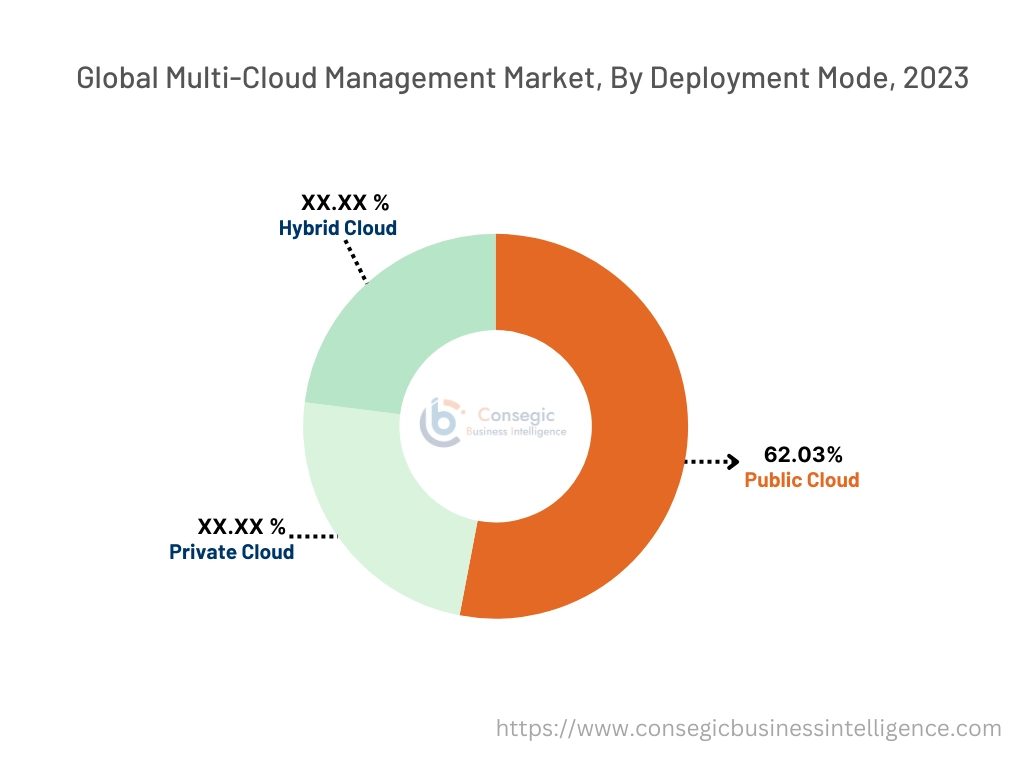
By Organization Size:
The market is segmented into Large Enterprises and Small & Medium Enterprises (SMEs).
Trends in the Organization Size:
- To improve data protection across operations, businesses are continuously adopting multi-cloud security.
- To ensure fast deployment of products and improve operational efficiency SMEs utilize cloud-native technologies.
The large enterprises sector accounted for the largest revenue share of the overall multi-cloud management market share in 2023.
- The solutions to reduced cloud vendor lock-in, operational efficiency, and availability of mission-critical applications are solved with the adoption of multi-cloud management by large enterprises.
- They provide improved visibility, continuous monitoring, and resource optimization across various platforms.
- The systems for disaster recovery are implemented by these large enterprises using such platforms ensuring enhanced work efficiency.
- In August 2022, VMware launched a multi-cloud management portfolio called VMware Aria in the VMware Explore 2022. This ensures the enhanced delivery of infrastructure and cloud-native applications, cost management, performance, and configuration.
- In conclusion, the analysis of the segment shows that risk management and utilization of resources efficiently position the sector as the largest in the market.
The small & medium enterprises (SMEs) sector is anticipated to register the fastest CAGR during the forecast period
- The cost-effectiveness and scalability of operations provided by multi-cloud platforms allow SMEs to increase operational efficiency and flexibility.
- They reduce the reliance on a single vendor or platform allowing them to optimize resource allocation through multiple vendors.
- This allows SMEs to focus on the core operations improving time management and simplifying the cloud management tasks.
- They reduce the risk of cyber threats or system failures, by improving data security and optimizing the disaster recovery system.
- In conclusion, the need for cost-effectiveness and scalability in SMEs drives the multi-cloud management market trends.
By Industry Vertical:
The market is segmented based on industry verticals into BFSI, Retail & E-commerce, Healthcare, IT & Telecom, Government, Manufacturing, and Others.
Trends in the Industry Vertical:
- Faster data processing, and lower latency across multi-cloud platforms are enabled by advancements in edge computing in the IT & Telecom sector.
- The integration of AI-driven solutions is driving and contributing to the enhancement of inventory management, demand forecasting, and real-time tracking.
The BFSI sector accounted for the largest revenue share in 2023.
- To ensure data privacy security, and regulatory compliance many BSFI organizations adopt multi-cloud solutions.
- These solutions enable improved resilience and optimized performance in critical operations in the BSFI institutions.
- Cloud-based analytics are also giving deeper insights to the institutions to enhance customer experience and improve detection of fraud.
- In July 2021, the IZO™ Financial Cloud platform was launched by Tata Communications. This ensures the optimization of data security and enhanced performance of banking and financial services.
- Hence, data security and enhanced customer satisfaction place the BSFI sector as the largest sector in the multi-cloud management market demand.
The healthcare sector is anticipated to register the fastest CAGR during the forecast period.
- The real-time data access across multiple cloud environments enhances patient care in the healthcare sector.
- The process such as cloud-based electronic health records (EHR), telemedicine, and medical imaging are enhanced with the integration of these platforms.
- They also improve collaboration in critical areas across the healthcare institutions, for medical research and precision medicine.
- In June 2022, a multi-cloud platform, which used the VMware Cloud Foundation was announced by Saudi Arabia's Ministry of Health (MoH) in order to make advancements in healthcare services. This utilizes a set of highly secure services in order to ensure resiliency, agility, and efficiency.
- In conclusion, the effectiveness of patient care and betterment in medical research drives the multi-cloud management market opportunities.
Regional Analysis:
The regions covered are North America, Europe, Asia Pacific, the Middle East and Africa, and Latin America.
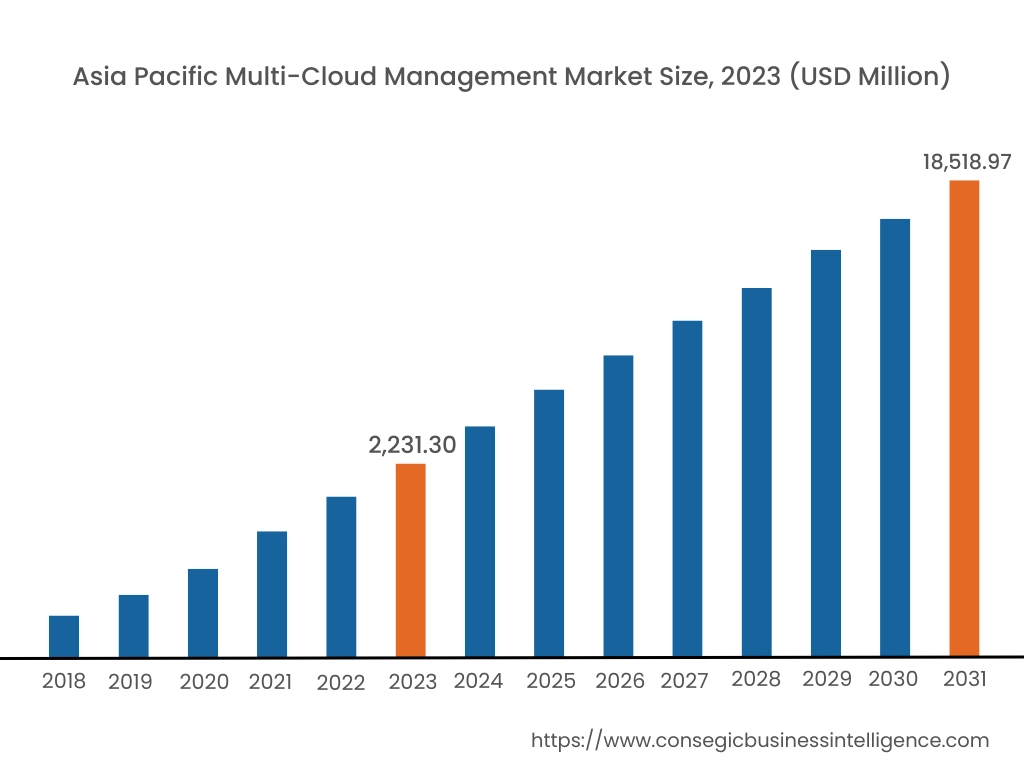
Asia Pacific region was valued at USD 2,231.30 Million in 2023. Moreover, it is projected to grow by USD 2,862.59 Million in 2024 and reach over USD 18,518.97 Million by 2031. Out of this, China accounted for the maximum revenue share of 34.5%.
As per the multi-cloud management market analysis, the growth in the adoption of digital platforms and cloud-based services in businesses is driving the market in this region. This is more significant in the industries like IT, telecom, and e-commerce, especially in the countries like China and India.
- A 2022 article by McKinsey Digital, highlights the surge in trend in cloud-based services in China, with the market growing from $32 billion in 2021 to $90 billion by 2025, majorly due to the increasing demand for elastic computing power across organizations.
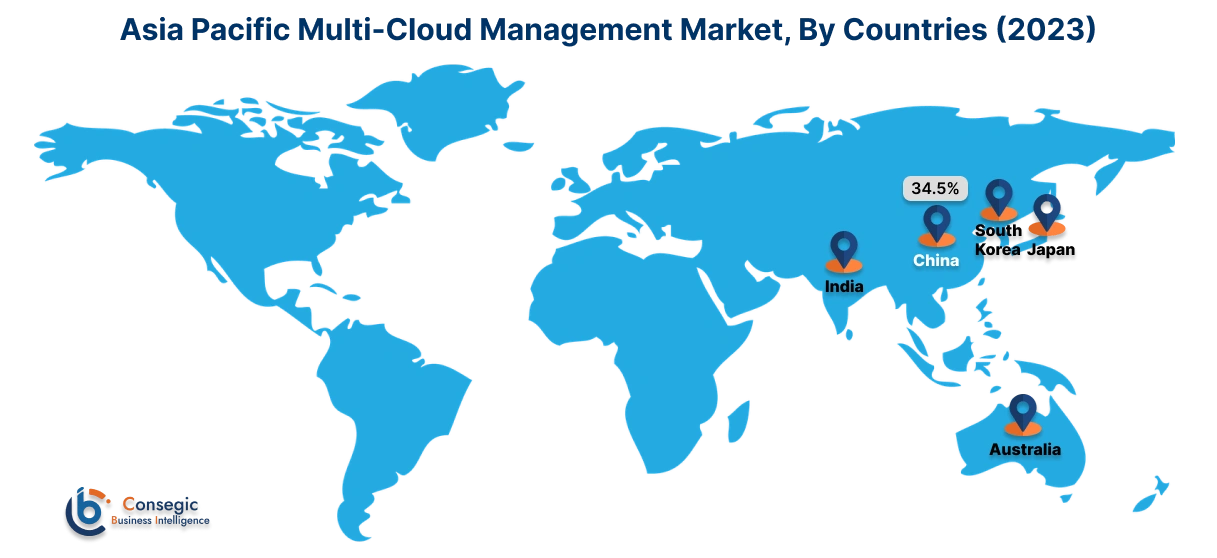
North America is estimated to reach over USD 23,678.62 Million by 2031 from a value of USD 2,940.49 Million in 2023 and is projected to grow by USD 3,762.74 Million in 2024. The growing dependence on cloud-native infrastructure and the rapid digitalization are driving the market in this region. There is also a significant increase in the adoption of multi-cloud platforms in industries such as finance, healthcare, and retail. The region also focuses on data privacy and stringent regulations further accelerating the multi-cloud management market expansion.
- In December 2023, Solix Common Data Platform 3.0 was launched by Solix Technologies, Inc., an American company . This technology is a multi-cloud data fabric solution, which ensures the monitoring and security of organizations' data.
The regional analysis portrays that the increasing data protection and privacy laws are driving the market in the region of Europe. In the Middle East and Africa, there is a growing trend towards modernizing IT infrastructure and enhancing recovery capabilities from disasters, further accelerating the market. Latin America's focus on scalable solutions and reduced costs in sectors like manufacturing and retail, is driving the multi-cloud management market expansion in this region.
Top Key Players & Market Share Insights:
The multi-cloud management market is highly competitive with major players providing products & services to the national and international markets. Key players are adopting several strategies in research and development (R&D), product innovation, and end-user launches to hold a strong position in the global multi-cloud management market. Key players in the multi-cloud management industry include -
- International Business Machines Corporation (USA)
- Microsoft Corporation (USA)
- Amazon Web Services, Inc. (USA)
- Google LLC (USA)
- Cisco Systems, Inc. (USA)
- VMware, Inc. (USA)
- Oracle Corporation (USA)
- BMC Software, Inc. (USA)
- Citrix Systems, Inc. (USA)
- Dell Technologies Inc. (USA)
Recent Industry Developments :
Product Launches:
- In June 2024, Verizon will launch a multi-cloud management solution, to provide a network-as-a-service offering. This simplifies the process of application deployment and cloud-connection management across the multi-cloud environment of the user.
- In February 2024, the release 2 of Project Nephio by Linux Foundation, was announced in order to advance multiple capabilities including multi-vendor, multi-cloud, and additional cloud-native automation ecosystems.
- In October 2023, BT launches Global Fabric, a multi-cloud network-as-a-service offering. It can connect multiple cloud platforms and provide several cloud services.
Mergers & Acquisitions:
- In March 2024, Nefeli Networks was acquired by Cloudflare, to launch the multi-cloud networking service called Magic Cloud Networking. This ensures the interoperability between different cloud platforms.
- In June 2024, Oracle and Google combine the Oracle Cloud and Google Infrastructure ensuring zero-cost cross-cloud transfer. This enables the streamlining of multi-cloud deployments.
Partnerships & Collaborations:
- In 2024, Oracle and Aws enter into a partnership, to complete the multi-cloud strategy. AWS's analytics, AI, and compute devices integrated with the Oracle database, reduce migration issues.
Multi-cloud Management Market Report Insights :
| Report Attributes | Report Details |
| Study Timeline | 2018-2031 |
| Market Size in 2031 | USD 69,725.04 Million |
| CAGR (2024-2031) | 29.7% |
| By Offering |
|
| By Deployment Mode |
|
| By Industry Vertical |
|
| By Application |
|
| By Region |
|
| Key Players |
|
| North America | U.S. Canada Mexico |
| Europe | U.K. Germany France Spain Italy Russia Benelux Rest of Europe |
| APAC | China South Korea Japan India Australia ASEAN Rest of Asia-Pacific |
| Middle East and Africa | GCC Turkey South Africa Rest of MEA |
| LATAM | Brazil Argentina Chile Rest of LATAM |
| Report Coverage |
|
Key Questions Answered in the Report
How big is the Multi-cloud Management Market? +
Multi-cloud Management Market size is estimated to reach over USD 69,725.04 Million by 2031 from a value of USD 8,729.38 Million in 2023 and is projected to grow by USD 11,162.78 Million in 2024, growing at a CAGR of 29.7% from 2024 to 2031.
What specific segmentation details are covered in the multi-cloud management market report? +
The multi-cloud management market report includes specific segmentation details for offering, deployment mode, organization size, industry vertical, and region.
Which is the fastest segment anticipated to impact the market growth? +
In the organization size segment, Small & Medium Enterprises (SMEs) are the fastest-growing segment during the forecast period due to the improved scalability and reduced cost.
Who are the major players in the multi-cloud management market? +
The key participants in the multi-cloud management market are International Business Machines Corporation (USA), Microsoft Corporation (USA), VMware, Inc. (USA), Amazon Web Services, Inc. (USA), Google LLC (USA), Cisco Systems, Inc. (USA), Oracle Corporation (USA), BMC Software, Inc. (USA), Citrix Systems, Inc. (USA), Dell Technologies Inc. (USA).
